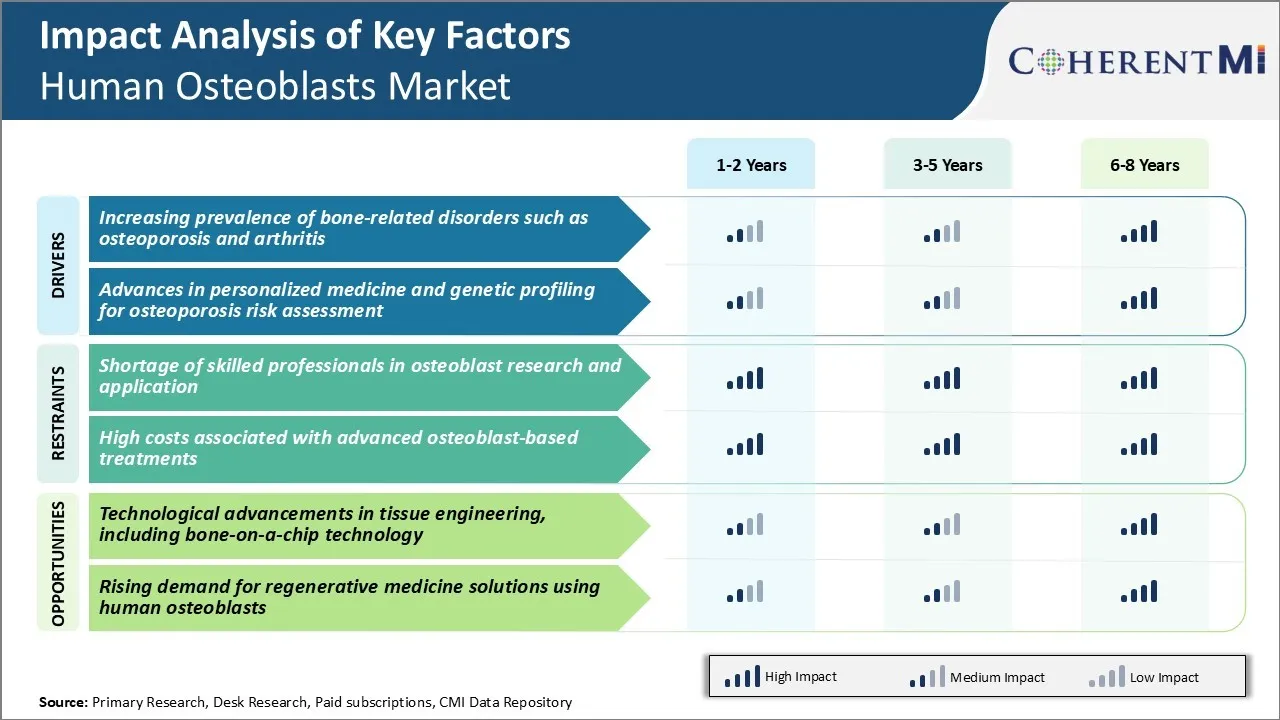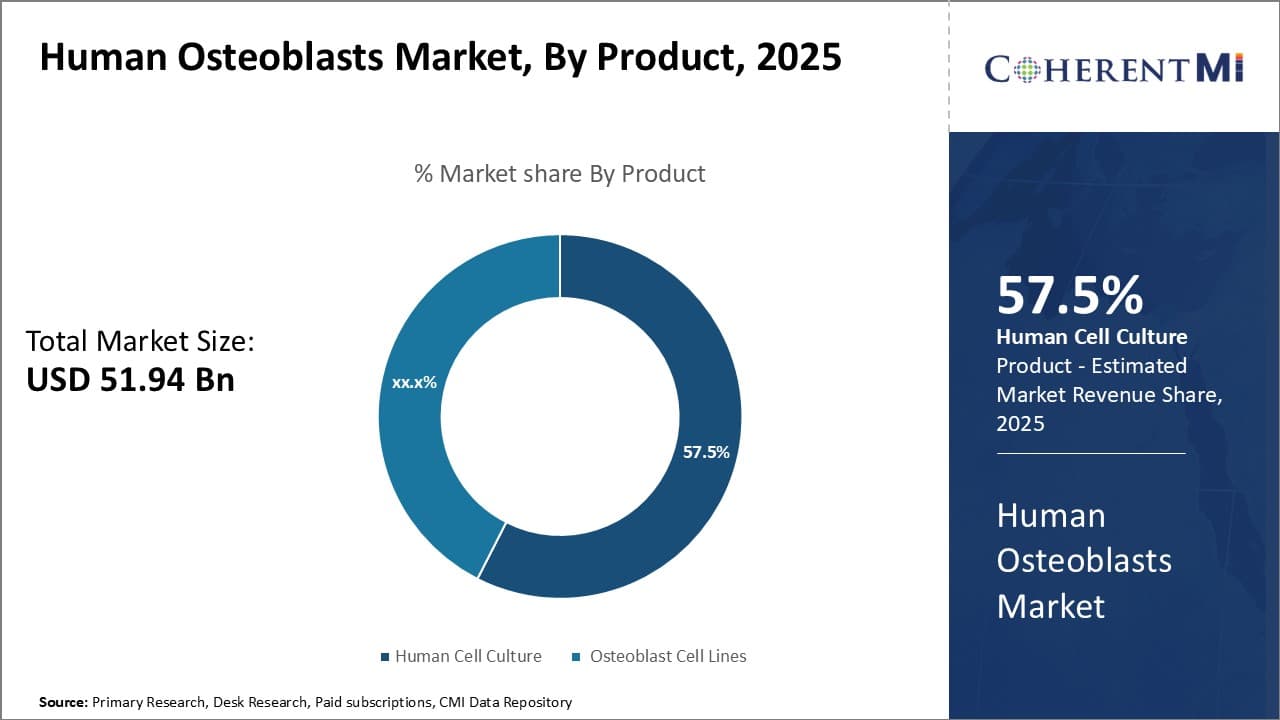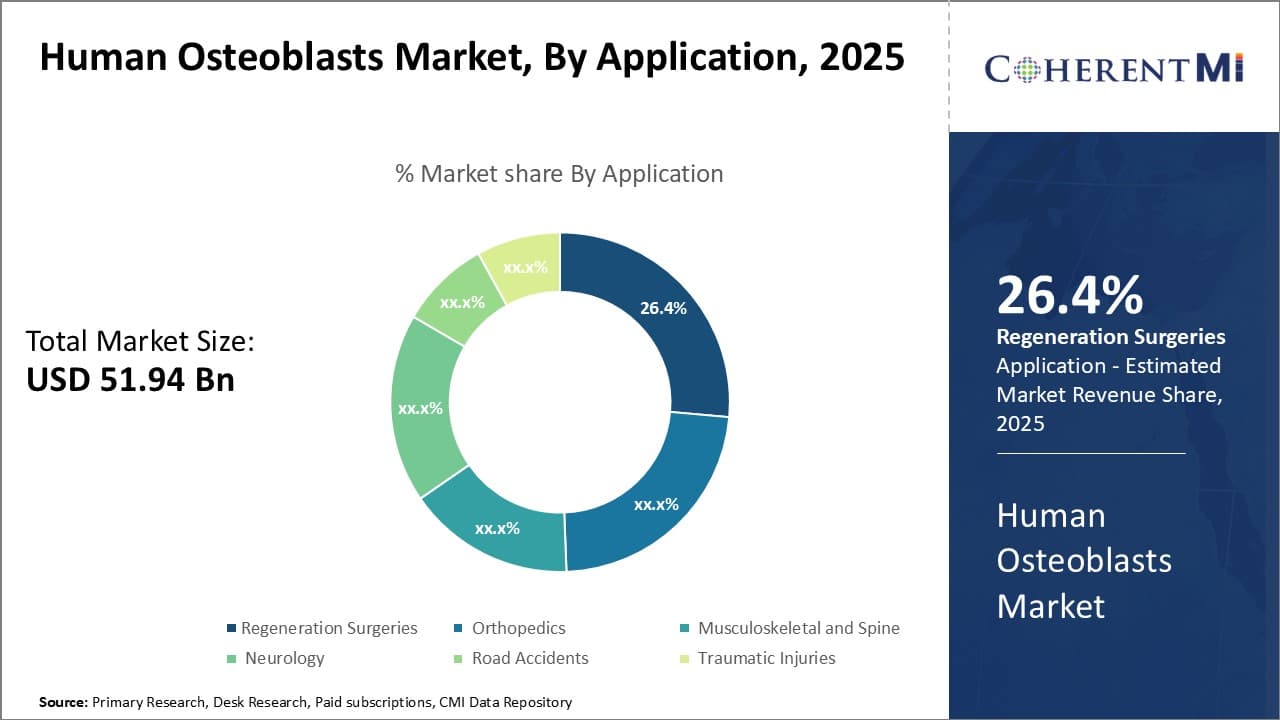Human Osteoblasts Market Size - Analysis
The human osteoblasts market is estimated to be valued at USD 48.72 Bn in 2025 and is expected to reach USD 81.25 Bn by 2032. It is projected to grow at a compound annual growth rate (CAGR) of 6.6% from 2025 to 2032. The human osteoblasts market is witnessing increased research activity focused on developing more effective osteoblast-targeting drugs and therapies.
Market Size in USD Bn
CAGR6.6%
| Study Period | 2025-2032 |
| Base Year of Estimation | 2024 |
| CAGR | 6.6% |
| Market Concentration | High |
| Major Players | Sigma Aldrich Chemicals Private Limited, Athersys Inc., Cytori Therapeutics Inc., U.S. Stem Cell Inc., Vericel Corporation and Among Others |
please let us know !
Human Osteoblasts Market Trends
Market Driver - Increasing Prevalence of Bone-related Disorders such as Osteoporosis and Arthritis
The worldwide occurrence of bone-associated conditions like osteoporosis and arthritis has risen markedly in recent years. Osteoporosis, a disease characterized by low bone mass and architectural deterioration of bone tissue, enhances fracture risk. It is estimated that over 200 million people suffer from this condition internationally. According to studies, approximately 250 million people worldwide have osteoarthritis of the knee.
The aging demographic transition underway will sustain demand for osteoblasts required for bone formation and repair. Already over 8% of the global population is aged 65 years or older as per United Nations data, highlighting vulnerability to osteoporosis and arthritis. China for instance contains over 130 million elderly individuals today and this tally is projected to more than double by 2050.
Worn out joints in the setting of osteoarthritis commonly undergo cell-based regeneration therapy using human osteoblasts for cushioning and flexibility restoration. Overall, the rising prevalence of bone disorders driven by aging populations represents a key driver bolstering the human osteoblasts market.
Market Driver - Advances in Personalized Medicine and Genetic Profiling for Osteoporosis Risk Assessment
Medical science is progressing rapidly towards customized treatment approaches tailored for every individual. In the sphere of osteoporosis, genetics research has enhanced understanding of the role played by variations in certain genes linked to low bone mass. Recent technological advancement now enable comprehensive profiling of an individual's complete set of genes through genome sequencing.
By combining genomic risk data with clinical risk factors, doctors can derive highly predictive personalized risk scores for osteoporosis development and fracture occurrence. This assists with optimizing prevention, early detection and proactive management of at-risk patients. It enables accurate targeting of lifestyle and drug therapies to those most likely to benefit.
Additionally, understanding the genetic underpinnings can expedite development of novel anabolic agents addressing specific pathological pathways. The rising application of precision medicine methodologies incorporating human genetics represents an important driver advancing the human osteoblasts market.

Market Challenge - Shortage of Skilled Professionals in Human Osteoblast Research and Application
The human osteoblast market currently faces a significant challenge in the shortage of skilled professionals who can conduct research and apply their findings. There is a lack of experienced scientists, engineers, and technicians who have extensive expertise in osteoblast biology, cell culture techniques, microscopy, and assay development.
Training new professionals requires a long timeline as it takes years of education and hands-on experience to gain proficiency. This skills gap threatens to slow the pace of scientific discovery and development of new human osteoblast-based treatments, devices, and diagnostics.
The few skilled experts who are available often demand very high compensation. Addressing this shortage will likely require increased funding for stem cell and tissue engineering education programs at universities. Until more trained professionals enter the workforce, research progress and commercialization potential may be limited within this promising field.
Market Opportunity - Technological Advancements in Tissue Engineering, Including Bone-on-a-Chip Technology
The human osteoblast market is poised to experience significant growth due to advancing tissue engineering technologies. One exciting area of development is bone-on-a-chip microfluidic systems that allow scientists to culture three-dimensional human osteoblast tissues on a small engineered platform. These bone-on-a-chip models can mimic the complex structure and functionality of real bone tissue in a lab setting.
Other tissue engineering techniques, such as 3D bioprinting and enhanced scaffold materials, are enabling the creation of functional bone grafts customized for patients. These technological advancements have the potential to transform treatment options for bone diseases, fractures, and implants. They could accelerate development of personalized medicine solutions.
The availability of advanced bone models is also likely to drive significant investment and partnerships between companies in sectors such as pharmaceuticals, medical devices, and healthcare. Widespread adoption of tissue engineering approaches may establish new standards for bone research and clinical applications in the human osteoblasts market.
Key winning strategies adopted by key players of Human Osteoblasts Market
Focused R&D and product innovation: Lonza launched its Lonza Osteoblast Cell System in 2015, which contains primary human osteoblast cells that more closely mimic in vivo bone cell behavior compared to immortalized cell lines. This helped Lonza gain a competitive edge in the human osteoblasts market.
Strategic partnerships and collaborations: In 2016, Thermo Fisher partnered with STEMCELL Technologies to expand its bone cell portfolio. This strengthened both companies' presence in human osteoblasts market.
Geographical expansion: PromoCell expanded its business beyond Europe and established local subsidiaries in North America and Asia-Pacific regions between 2010-2015.
Focus on customized solutions: Companies in the human osteoblasts market provide specialized osteoblast cell types and customized assay services to meet unique research needs. For example, Lonza's human primary cancellous osteoblasts are suitable for modeling bone remodeling at tissue–implant interfaces.
Segmental Analysis of Human Osteoblasts Market

Insights, By Product: Advancements in Cell Culture Techniques Drive Growth in the Human Cell Culture Segment
The human cell culture segment holds 57.5% share in the product category of the human osteoblasts market in 2025. This can be attributed to the rapid advancements being made in cell culture techniques over the past few decades. It allows researchers to isolate primary human osteoblasts and grow them in controlled conditions for experiments. Various cell culture methods and media formulations have been developed to optimize human osteoblast growth, differentiation, and mineralization.
Government funding for bone disease research and stem cell therapy development programs have encouraged academic labs and biotech firms to focus on human osteoblast biology. Many are incorporating primary human osteoblast cultures in their studies on bone formation, remodeling and metabolic bone diseases. This growing research base continues to drive the need for reliable commercial sources of human osteoblasts in sufficient quantities and quality. Overall, technological progress in cell culture techniques that better mimic the native bone niche will ensure sustained demand for the human cell culture segment in the human osteoblast market.
 Insights, By Application: Regeneration Applications See Increased Use of Osteoblasts due to the Aging Population
Insights, By Application: Regeneration Applications See Increased Use of Osteoblasts due to the Aging Population
Within the application segment of the human osteoblast market, regeneration surgeries account for 26.4% share in 2025. This can be attributed to the rising global trend of an aging population undergoing more bone regeneration procedures.
With better medical care and lifestyle, average human lifespans have increased significantly in recent decades. However, this has led to a rise in age-related bone fractures, joint failures and spinal issues requiring surgical interventions. Unlike in the past where joint replacements or spinal fusion were the only options, surgeons now have human osteoblast-based regeneration therapies. These involve seeding patients' own bone marrow stem cells or allograft osteoblasts on implant materials like calcium phosphate scaffolds.
When implanted, the human osteoblasts initiate new bone formation to fill defects or fuse vertebrae. Overall, regenerative demand from an aging global population needing bone grafts will support continued relevance of osteoblast usage in surgery.
Insights, By End User: Hospitals Focus on Specialized Orthopedic Care Driving Human Osteoblast Usage
Within the end user segment of the human osteoblast market, the hospital sector accounts for the largest share. This can be attributed to hospitals increasingly focusing on specialized orthopedic and musculoskeletal care driven by aging demographics. Providing specialized orthopedic services requires significant infrastructure for advanced surgical suites, bone banks, and dedicated staff.
Partnering with universities, many leading hospitals in the human osteoblasts market initiate osteoblast-based research projects in regenerative therapies. They offer clinical trials on novel osteoblast products to stay at the forefront of advancing care standards. Additional translation-focused projects involve isolating and characterizing osteoblasts sourced from patients undergoing various orthopedic procedures.
Overall, the trend of specialized musculoskeletal hospitals developing as destinations for advanced orthopedic treatment will continue the hospital sector's prominent status in the human osteoblast market end user segment.
Additional Insights of Human Osteoblasts Market
- The rise in traumatic injuries and road accidents has significantly increased the demand for regenerative surgeries.
- Human osteoblasts are being utilized for advanced orthopedic treatments, including musculoskeletal and spinal surgeries.
- North America dominates the human osteoblasts market due to high healthcare spending on musculoskeletal problems.
- Asia-Pacific is the fastest-growing region in the global human osteoblasts market, driven by biopharmaceutical advancements and increasing healthcare investments.
Competitive overview of Human Osteoblasts Market
The major players operating in the human osteoblasts market include Sigma Aldrich Chemicals Private Limited, Athersys Inc., Cytori Therapeutics Inc., U.S. Stem Cell Inc., Vericel Corporation, Wright Medical Group N.V, Cerapedics Inc., CryoLife, Inc., Zimmer Biomet, and PromoCell GmbH.
Human Osteoblasts Market Leaders
- Sigma Aldrich Chemicals Private Limited
- Athersys Inc.
- Cytori Therapeutics Inc.
- U.S. Stem Cell Inc.
- Vericel Corporation
Human Osteoblasts Market - Competitive Rivalry

Human Osteoblasts Market
(Dominated by major players)
(Highly competitive with lots of players.)
Recent Developments in Human Osteoblasts Market
- In October 2024, Smith+Nephew launched the LEGION Hinged Knee System with proprietary OXINIUM (Oxidized Zirconium) implant technology in the United States. This innovation offers improved wear resistance, corrosion resistance, and durability.
Human Osteoblasts Market Segmentation
- By Product
- Human Cell Culture
- Osteoblast Cell Lines
- By Application
- Regeneration Surgeries
- Orthopedics
- Musculoskeletal and Spine
- Neurology
- Road Accidents
- Traumatic Injuries
- By End User
- Hospitals
- Specialty Clinics
- Ambulatory Surgical Centers

Would you like to explore the option of buying individual sections of this report?
Vipul Patil is a dynamic management consultant with 6 years of dedicated experience in the pharmaceutical industry. Known for his analytical acumen and strategic insight, Vipul has successfully partnered with pharmaceutical companies to enhance operational efficiency, cross broader expansion, and navigate the complexities of distribution in markets with high revenue potential.
Frequently Asked Questions :
How big is the human osteoblasts market?
The human osteoblasts market is estimated to be valued at USD51.94 Bn in 2025 and is expected to reach USD 81.25 Bn by 2032.
What are the key factors hampering the growth of the human osteoblasts market?
Shortage of skilled professionals in osteoblast research and application and high costs associated with advanced osteoblast-based treatments are the major factor hampering the growth of the human osteoblasts market.
What are the major factors driving the human osteoblasts market growth?
The increasing prevalence of bone-related disorders such as osteoporosis and arthritis and advances in personalized medicine and genetic profiling for osteoporosis risk assessment are the major factor driving the human osteoblasts market.
Which is the leading product in the human osteoblasts market?
The leading product segment is human cell culture.
Which are the major players operating in the human osteoblasts market?
Sigma Aldrich Chemicals Private Limited, Athersys Inc., Cytori Therapeutics Inc., U.S. Stem Cell Inc., Vericel Corporation, Wright Medical Group N.V, Cerapedics Inc., CryoLife, Inc., Zimmer Biomet, and PromoCell GmbH are the major players.
What will be the CAGR of the human osteoblasts market?
The CAGR of the human osteoblasts market is projected to be 6.6% from 2025-2032.